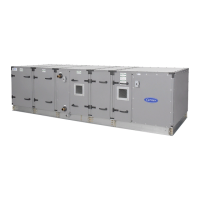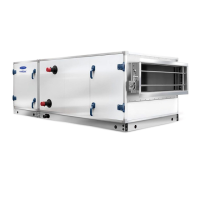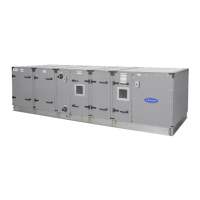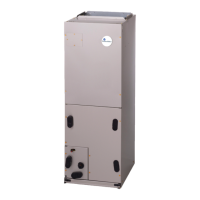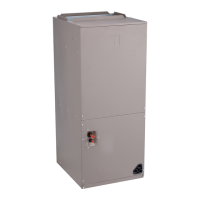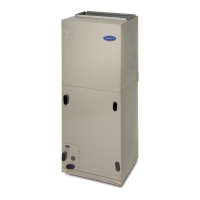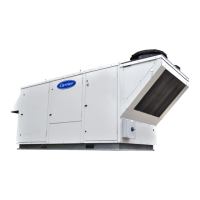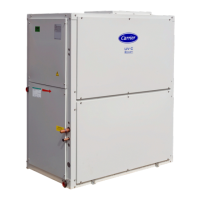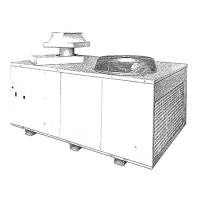MOTOR POWER WIRING — The fan section is provided
with a decal indicating the recommended location to drill or
punch hole(s) to accommodate an electrical conduit for the
fan-motor wiring. The decal is located on the motor side,
approximately 4-in. in from the side and 4-in. down from
the top of the corner above where the motor will be in-
stalled. Where possible, the conduit should be installed in a
panel which will not be removed, such as the discharge panel.
MOTOR OVERLOAD PROTECTION — Fan-motor start-
ers and overload protectors are field-supplied and installed.
A label on the fan motor indicates the correct size of the
overload protectors required to be installed in the motor starter.
Sheaves — Factory-supplied drives are prealigned and
tensioned, however, Carrier recommends that you check the
belt tension and alignment before starting the unit. Always
check the drive alignment after adjusting belt tension.
To install sheaves on the fan or motor shaft, remove any
rust-preventive coating on the shaft. Make sure the shaft is
clean and free of burrs. Add grease or lubricant to bore of
sheave before installing. Mount sheave on the shaft; to pre-
vent bearing damage, do not use excessive force. Place sheaves
for minimum overhang (see Fig. 24).
Each factory-assembled fan, shaft, and drive sheave as-
sembly is precision aligned and balanced. If excessive unit
vibration occurs after field replacement of sheaves, the unit
should be rebalanced. To change the drive ratio, reselect and
replace the motor sheave, not the fan sheave.
After 24 hours of unit operation, the drive belts may stretch.
Check the belt tension after 24 hours of operation and adjust
if necessary. Periodically check belt tension throughout the
run-in period, which is normally the initial 72 hours of
operation.
ALIGNMENT — Make sure that fan shafts and motor shafts
are parallel and level. The most common causes of mis-
alignment are nonparallel shafts and improperly located sheaves.
Where shafts are not parallel, belts on one side are drawn
tighter and pull more than their share of the load. As a result,
these belts wear out faster, requiring the entire set to be re-
placed before it has given maximum service. If misalign-
ment is in the sheave, belts enter and leave the grooves at an
angle, causing excessive belt and sheave wear.
1. Shaft alignment can be checked by measuring the dis-
tance between the shafts at 3 or more locations. If the
distances are equal, then the shafts are parallel.
2. Sheave Alignment:
Fixed sheaves — To check the location of the fixed sheaves
on the shafts, a straightedge or a piece of string can be
used. If the sheaves are properly aligned, the string will
touch them at the points indicated by the arrows in
Fig. 26.
Adjustable sheave — To check the location of adjustable
sheave on shaft, make sure that the centerlines of both
sheaves are in line and parallel with the bearing support
channel. See Fig. 26. Adjustable pitch drives are installed
on the motor shaft.
With adjustable sheave, do not exceed maximum fan
speed (rpm).
3. Rotate each sheave a half revolution to determine whether
the sheave is wobbly or the drive shaft is bent. Correct
any misalignment.
4. With sheaves aligned, tighten cap screws evenly and
progressively.
NOTE: There should be a
1
⁄
8
-in. to
1
⁄
4
-in. gap between the
mating part hub and the bushing flange. If gap is closed,
the bushing is probably the wrong size.
5. With taper-lock bushed hubs, be sure the bushing bolts
are tightened evenly to prevent side-to-side pulley wobble.
Check by rotating sheaves and rechecking sheave align-
ment. When substituting field-supplied sheaves for factory-
supplied sheaves, consider that fan shaft sheave has been
factory balanced with fan and shaft as an assembly. For
this reason, substitution of motor sheave is preferable for
final speed adjustment.
Fig. 24 — Determining Sheave-Shaft Overhang
Fig. 25 — Sealing Power Wires in Flexible Conduit
38
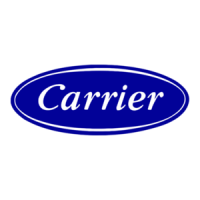
